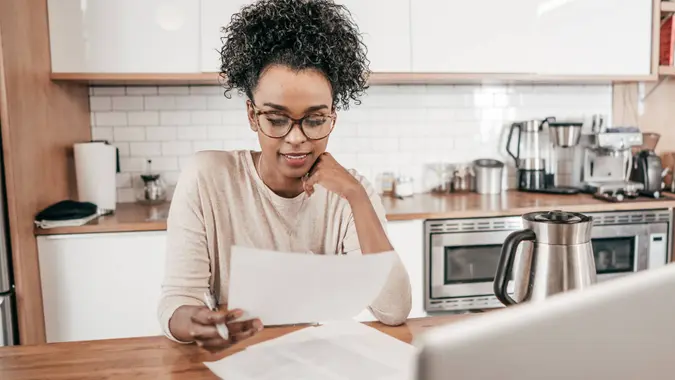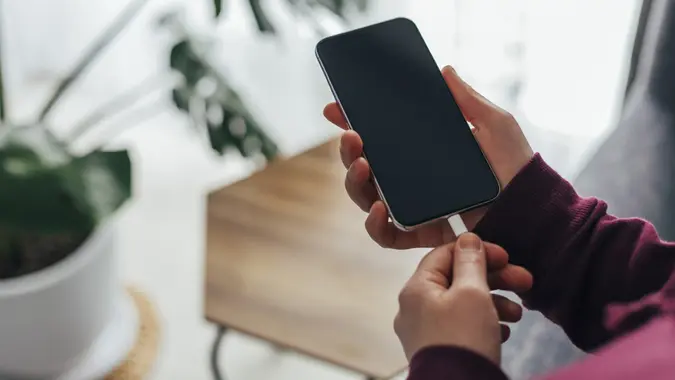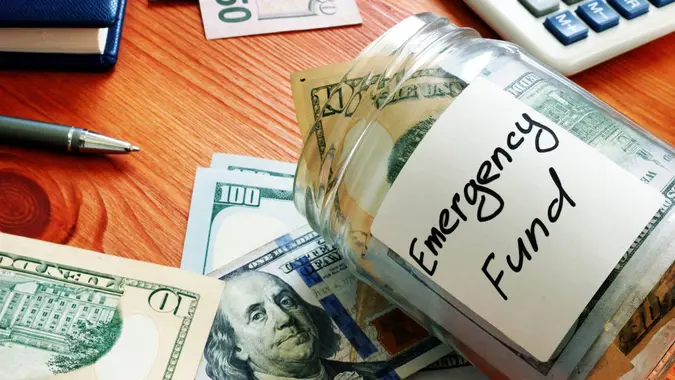How Much Should an Emergency Fund Be?

Commitment to Our Readers
GOBankingRates' editorial team is committed to bringing you unbiased reviews and information. We use data-driven methodologies to evaluate financial products and services - our reviews and ratings are not influenced by advertisers. You can read more about our editorial guidelines and our products and services review methodology.

20 Years
Helping You Live Richer

Reviewed
by Experts

Trusted by
Millions of Readers
An emergency fund can be a financial lifesaver when unexpected expenses or job loss occur. A common rule of thumb is to save three to six months’ worth of expenses — closer to six if your income is variable, and around three if you have a stable paycheck.
Good To Know: Emergency Fund Basics
- What it is: A cash reserve for unexpected expenses — so you don’t have to dip into your regular savings.
- How much to save: Aim for three to six months’ worth of expenses.
- When to use it: Job loss, medical emergencies, car or home repairs, unexpected travel costs
- Where to keep it: A high-yield savings account for easy access and better interest
How Much Should You Save in an Emergency Fund?
A good rule of thumb is to save three to six months’ worth of expenses. A three-month cushion may fit those who have a stable, consistent income, while a six-month fund is more appropriate for freelancers and independent contractors.
Not sure how much to set aside? This table offers a quick guide.
| Monthly Expenses | Three-Month Emergency Fund | Six-Month Emergency Fund |
|---|---|---|
| $2,000 | $6,000 | $12,000 |
| $3,000 | $9,000 | $18,000 |
| $4,000 | $12,000 | $24,000 |
| $5,000 | $15,000 | $30,000 |
What Factors Influence Your Emergency Fund Size?
Building the right-sized emergency fund requires evaluating certain factors.
Household Size
Larger families will need more of an emergency fund than a single adult or a couple. The expenses in a larger family will likely include food, health care and childcare. Your emergency fund should be able to support you, your partner and any dependents.
Monthly Expenses
Consider your monthly expenses. If you suddenly lost your source of income, which payments would you still need to make? Your monthly budget might include:
- Housing — rent or mortgage payments
- Childcare
- Grocery budget
- Utilities
- Health, auto and home insurance
- Loan payments
Some payments you don’t need to factor into an emergency budget include:
- Streaming services
- Non-essential shopping
- Vacations and meals out
- Long-term savings, including contributions to your 401(k) or other investment accounts
Job Stability and Income
If you’re a contractor, freelancer or someone who doesn’t necessarily receive a consistent paycheck, consider saving closer to six to nine months’ worth of savings. Those who have more of a stable income may be able to have a smaller cushion.
Location and Risk Factors
Living in a place where health care costs are high or there are greater chances of natural disasters may justify having a larger emergency fund.
Where To Keep Your Emergency Fund
Not all savings accounts are created equal — here’s how the top options compare.
| Account Type | Best For | Interest Earned | Access | Risk Level | FDIC-Insured | Notes |
|---|---|---|---|---|---|---|
| High-yield savings | Earning interest and easy access | High | Immediate or up to two days | Low | Yes | Best option for emergency funds since it is safe and can allow your money to grow |
| Money market account | Larger balances and check writing | Medium to high | One to two days | Low | Yes | May require larger balances |
| Traditional savings | Simplicity and branch access | Low | Same day | Low | Yes | Good option for beginner accounts |
| Cash at home | Sudden emergencies | None | Immediate | Low to moderate | No | Keep a small amount — less than $500 in a fireproof safe |
Where Not To Keep Your Emergency Fund
If you want to keep your emergency fund safe, you want to avoid accounts and investments that are too risky or volatile. Those accounts include:
- Stocks or mutual funds: The shifts in the market could wipe out your savings. You don’t want to be vulnerable to the volatility of the market especially when you need the funds the most.
- Cryptocurrency: It isn’t ideal to invest in crypto since it has wide fluctuations.
- Retirement accounts: You want easy, penalty-free access to your funds, and withdrawing funds from retirement accounts may trigger various penalties.
How To Start Building Your Emergency Fund
It is easy to start building an emergency fund, but you need to be consistent in order to make it grow. Here are a few tips:
Set a Target Goal
Decide how much you need to save for your emergency fund. It may be $500 or $1,000 to start. Keep building toward saving three to six months’ worth of savings.
Open a Separate Account
Ideally, you want to open a separate account for your emergency funds. A high-yield savings account will help your money grow.
Automate Your Savings
You can set up automatic transfers so that every time you get paid, funds will be sent to your savings account.
Cut Unnecessary Spending
Take a look at your expenses and determine if you can cut some of these costs. You can look at cutting subscription services, eating out or impulse shopping.
Mistakes To Avoid With Emergency Funds
Here are some common mistakes you should avoid with your emergency fund:
- Not saving enough. Don’t underestimate how much you should save. It could leave you short, especially when you need the money.
- Letting the funds sit in a low-interest account. Give your money a chance to grow, and make sure you invest the funds in a high-yield savings account.
- Keeping funds in a risky investment. Don’t place your funds in stocks or other volatile investments.
- Using the funds. Don’t spend the funds on vacations or shopping. You need to use your funds for true emergencies.
Final Take: Just Start Saving What You Can
Ready to build your fund? Start with these practical steps.
- Tailor your emergency fund based on the number of people in your household, your monthly budget, job stability and risk exposure.
- Start small and stay consistent with your emergency fund. Begin with $500 to $1,000 and automate transfers. Build up gradually without derailing your other financial goals.
- Save three to six months of expenses. Independent contractors or those with less stable income may want to consider saving six months’ worth, while those who have stable jobs may want to think about saving three months’ worth of expenses.
- Allow your emergency fund to grow in a high-yield savings account.
- Don’t use your emergency fund for vacations, shopping trips or a non-emergency.
Emergency Fund FAQ
Still have questions about how emergency funds work? Here are quick answers to the most common ones.- How much should an emergency fund be for a family of four?
- You should aim to save three to six months' worth of expenses, which could range from $15,000 to $30,000 depending on your lifestyle.
- Should I keep my emergency fund in a savings account?
- Yes, a high-yield savings account is ideal since it can earn interest and keep your funds safe.
- Can I build an emergency fund while paying off debt?
- Yes, start small by saving a small balance while also paying off debt.
- Is $20,000 too much for an emergency fund?
- If you have an unstable income or a high standard of living, $20,000 may not be enough for an emergency fund.
- Is $5,000 enough for an emergency fund?
- For a single individual, $5,000 may be enough for the short term, but for couples and families, it may be too little.
Quinlan Grim and Jacob Wade contributed to the reporting for this article.
 Written by
Written by  Edited by
Edited by 

























